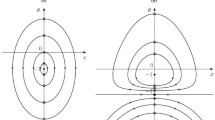Abstract
This paper considers a linear continuous-discrete time-varying system described by a set of differential and difference equations on a finite horizon. For such a hybrid system, the concept of the generalized \({{\mathcal{H}}}_{2}\) norm is introduced, representing the induced norm of a linear operator generated by the system under consideration. This norm is characterized in terms of Lyapunov difference equations and also in terms of recursive linear matrix inequalities. Discrete time-varying optimal controllers, including multiobjective ones, that minimize the generalized \({{\mathcal{H}}}_{2}\) norm of the closed loop system are designed.



Similar content being viewed by others
References
Balandin, D. V. & Kogan, M. M. Pareto Optimal Generalized H2-control and Vibroprotection Problems. Autom. Remote Control 78(no. 8), 1417–1429 (2017).
Balandin, D. V., Biryukov, R. S. & Kogan, M. M. Optimal Control of Maximum Output Deviations of a Linear Time-Varying System on a Finite Horizon. Autom. Remote Control 80(no. 10), 1783–1802 (2019).
Balandin, D. V., Biryukov, R. S. & Kogan, M. M. Minimax Control of Deviations for the Outputs of a Linear Discrete Time-Varying System. Autom. Remote Control 80(no. 12), 2091–2107 (2019).
Balandin, D. V., Biryukov, R. S. & Kogan, M. M. Finite-Horizon Multi-Objective Generalized H2 Control with Transients. Automatica 106(no. 8), 27–34 (2019).
Chellaboina, V., Haddad, W.M., Bernstein, D.S., and Wilson, D.A., Induced Convolution Operator Norms for Discrete-time Linear Systems, Proc. 38th IEEE Conference on Decision and Control, 1999, 487-492.
Khargonekar, P. P. & Sivashankar, N. \({{\mathcal{H}}}_{2}\) Optimal Control for Sampled-data Systems. Syst. Control Lett. 17(no. 6), 425–436 (1991).
Kim, J. H. & Hagiwara, T. Extensive Theoretical/numerical Comparative Studies on \({{\mathcal{H}}}_{2}\) and Generalized \({{\mathcal{H}}}_{2}\) Norms in Sampled-data Systems. Int. J. Control 90(no. 11), 2538–2553 (2017).
Kim, J. H. & Hagiwara, T. Upper/lower Bounds of Generalized \({{\mathcal{H}}}_{2}\) Norms in Sampled-data Systems with Convergence Rate Analysis and Discretization Viewpoint. Syst. Control Lett. 107, 28–35 (2017).
Rotea, M. A. The Generalized \({{\mathcal{H}}}_{2}\) Control Problem. Automatica 29(no. 2), 373–385 (1993).
Wilson, D. A. Convolution and Hankel Operator Norms for Linear Systems. IEEE Trans. Autom. Control 34, 94–97 (1989).
Wilson, D. A., Nekoui, M. A. & Halikias, G. D. An LQR Weight Selection Approach to the Discrete Generalized H2 Control Problem. Int. J. Control 71(no. 1), 93–101 (1998).
Author information
Authors and Affiliations
Appendices
Appendix
Proof of Theorem 1. For operator (3) consider its dual operator \({{\mathcal{S}}}^{* }\) defined as
where
The norm of the operator \({{\mathcal{S}}}^{* }\) is given by
due to duality, it has the property
Thus, the norm of the operator \({\mathcal{S}}\) can be calculated through the norm of its dual operator \({{\mathcal{S}}}^{* }\), which is much easier to calculate; see below.
For obtaining an expression for the operator \({{\mathcal{S}}}^{* }\), consider an element \(z\in {l}_{1}([0,N],{{\mathbb{R}}}^{n})\). Then
where y = (x0, ξ0, v, w) and the scalar product in the left-hand side is given by
The scalar product in the right-hand side has the form
which matches well the definition of norm (4).
Rewrite system (1) in the semi-discrete form. This means that the continuous variable x is subject to discretization, whereas the continuous external disturbances v remains untouched:
where ωk = column(v(t), wk) and
Now write a closure connecting the vectors
For this purpose, take advantage of relation (A.4). As a result,
where
Thus, the operator \({\mathcal{S}}\) can be represented as \({\mathcal{S}}=\widetilde{C}\widetilde{A}\widetilde{{\mathcal{B}}}\). In view of expression (A.3), the dual operator \({{\mathcal{S}}}^{* }\) can be obviously written as
where \({\widetilde{{\mathcal{B}}}}^{* }={\rm{diag}}\left({R}^{-1},{{\mathcal{B}}}_{0}^{* },\ldots ,{{\mathcal{B}}}_{N-1}^{* }\right)\) and
Next, the following expression can be easily checked using representation (A.7):
where
Since the matrix \(\widetilde{C}\) is block-diagonal, consider an auxiliary block-diagonal matrix \(\widetilde{Y}={\rm{diag}}\left({Y}_{0},\ldots ,{Y}_{N}\right)\) with the same blocks on the leading diagonal as the matrix W. The blocks Yk satisfy the linear recursive equation
which coincides with Eq. (9). Moreover, the following transformations are valid:
The last expression in this chain coincides with (8). The proof of Theorem 1 is complete.
Proof of Theorem 2. For deriving expression (10), assume that the value of the generalized \({{\mathcal{H}}}_{2}\) norm is equal to γ* and is achieved at a time instant k = k*. In this case, there exists an element
such that
The equality \({\parallel}{\widetilde{z}}^{* }{\parallel }_{{l}_{1}}=1\) indicates that \({z}_{{k}^{* }}={e}_{\max }\left({\widehat{C}}_{{k}^{* }}{Y}_{{k}^{* }}{\widehat{C}}_{{k}^{* }}^{\top }\right)\), where \({\widetilde{y}}^{* }={{\mathcal{S}}}^{* }{\widetilde{z}}^{* }={\rm{column}}\,({\zeta }^{* },{\omega }_{0}^{* },\ldots ,{\omega }_{N-1}^{* })\) is the vector composed of the worst-case initial conditions and external disturbances; in addition, \({\parallel}{\widetilde{y}}^{* }{\parallel }_{(R,2)}={\gamma }^{* }\). Note that for calculating \({\widetilde{y}}^{* }\) it is necessary to select the k*th column from the matrix representation of the operator \({{\mathcal{S}}}^{* }\):
Finally, for obtaining expression (10), just multiply the vector \({\widetilde{y}}^{* }\) by 1/γ*, because the vector of the worst-case initial conditions and external disturbances in the definition of the generalized \({{\mathcal{H}}}_{2}\) norm (5) satisfies the condition \({\parallel}{\widetilde{y}}^{* }{\parallel }_{(R,2)}=1\). The proof of Theorem 2 is complete.
Proof of Theorem 4. Write the equation of the closed loop system (12), (13):
In accordance with Theorem 3, the generalized \({{\mathcal{H}}}_{2}\) norm of system (A.9) can be calculated as the solution of problem (11) in which the matrices \({\widehat{A}}_{k}\) and \({\widehat{C}}_{k}\) are replaced by \({\widehat{A}}_{k}+{\widehat{H}}_{k}{\widehat{\Theta }}_{k}\) and \({\widehat{C}}_{k}+{D}_{k}{\widehat{\Theta }}_{k}\), respectively. Introducing the new variables \({Z}_{k}={\widehat{\Theta }}_{k}{Y}_{k}\), finally arrive in inequalities (14). The proof of Theorem 4 is complete.
Proof of Theorem 6. For proving this result, take notice that equality (17) can be written as
Hence, in inequalities (14) it suffices to replace the matrices \({\widehat{C}}_{k}\) and \({\widehat{D}}_{k}\) by the matrices \({\alpha }_{j}^{-1}{\widehat{C}}_{k}^{(j)}\) and \({\alpha }_{j}^{-1}{\widehat{D}}_{k}\), which yields inequalities (18). The proof of Theorem 6 is complete.
Funding
This work was supported by the Russian Foundation for Basic Research, projects nos. 18-41-520002, 19-01-00289, project no. 0729-2020-0055, and by the Research and Education Mathematical Center “Mathematics for Future Technologies.”
Rights and permissions
About this article
Cite this article
Biryukov, R. Generalized \({{\mathcal{H}}}_{2}\) Control of a Linear Continuous-Discrete System on a Finite Horizon. Autom Remote Control 81, 1394–1404 (2020). https://doi.org/10.1134/S0005117920080032
Received:
Revised:
Accepted:
Published:
Issue Date:
DOI: https://doi.org/10.1134/S0005117920080032



